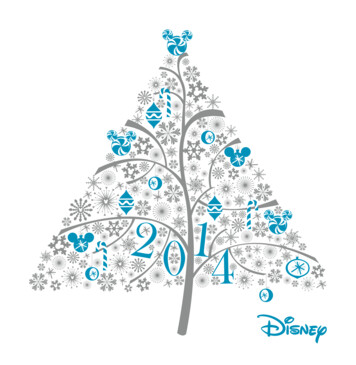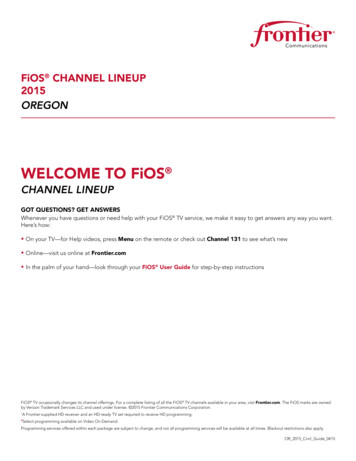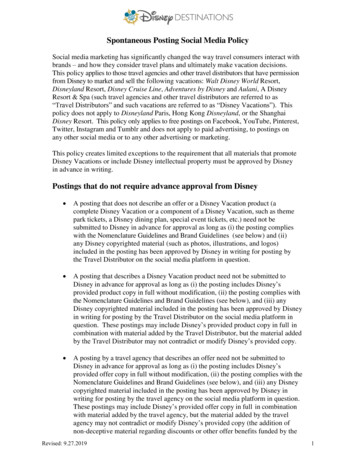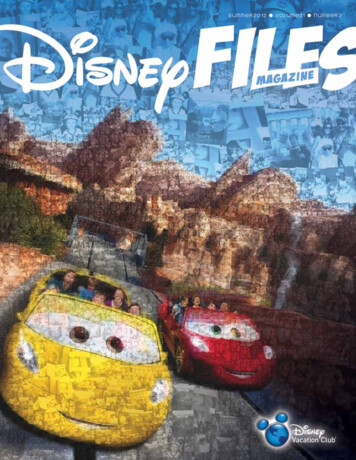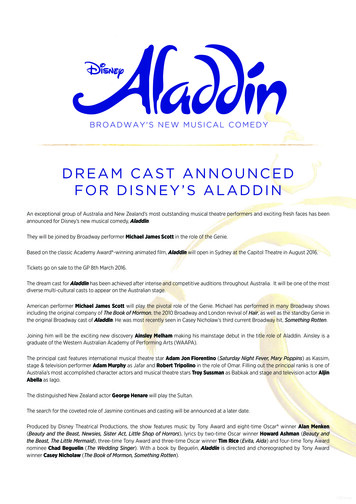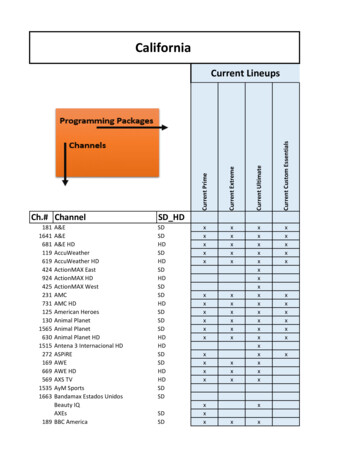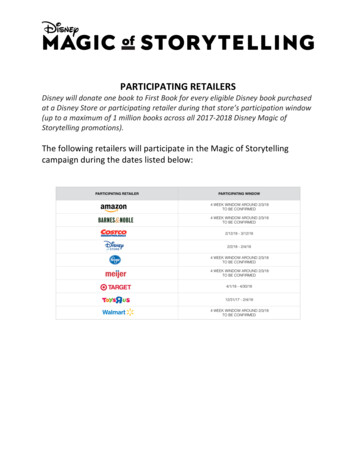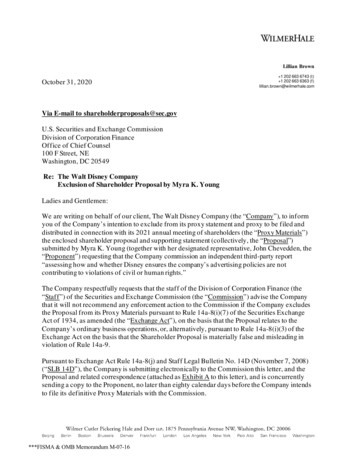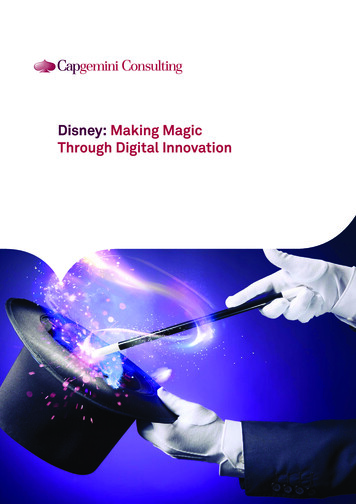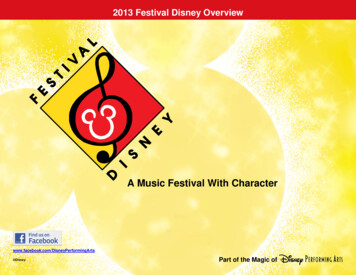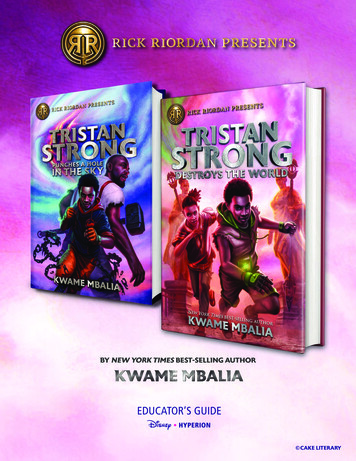
Transcription
BY NEW YORK TIMES BEST-SELLING AUTHOREDUCATOR’S GUIDEDisney HYPERION CaKE LITERaRY
TRISTAN STRONGPUNCHES A HOLE IN THE SKYABOUT THE BOOKTristan Strong is a seventh grader who is navigating the road to healingfollowing several difficult life events. First, he blames himself for thedeath of his best friend, Eddie. Then he disappoints his family bylosing a highly anticipated boxing match. When it seems like thingscan’t get any worse, he is sent to spend a month at his grandparents’farm in Alabama. During his first night on the farm, a series of strangeevents occurs. To his surprise, someone tries to steal the only thing hehas left of Eddie—a journal. Tristan chases the assailant and ends upin another universe filled with new friends and enemies. Following hisarrival, Tristan strategizes a way to win a high-stakes war by enticingthe trickster god Anansi. Can Tristan save his new friends and avoidmore loss? Readers everywhere will appreciate the connections tofamiliar African and African American folklore, adventures, and thecharacter development of Tristan throughout the novel.Common Core AlignmeNtThe Tristan Strong series provides a great opportunity to apply complex literacy skills such as inferencing,deconstructing vocabulary, identifying author’s purpose, answering text-dependent questions, and makingtextual connections. This discussion guide provides suggestions aligned with the Common Core StateStandards (CCSS) for Reading: Literature, Writing, and Speaking and Listening. Each activity in thisguide includes a reference for the CCSS strand, domain, and standard that is addressed. To supportinstruction or obtain additional information visit the Common Core State Standards (CCSS) websitewww.corestandards.org. Instructional Note: During each of the activities, please encourage students to support their claimswith evidence from the text and illustrations. Providing young learners with the opportunity toanswer text-dependent questions is critical to success with Common Core State Standards (CCSS). CAKE LITERARY 2
ActivatIng BackgroUnd KnowledGeExplore Important Connections Before Reading1.Traditional fables typically have the following components, ( ) they feature an animal with humancharacteristics (e.g., the ability to speak); ( ) each character usually has one personality trait, such as beingclever, that is evident throughout the story; ( ) a problem or conflict; ( ) a resolution, moral, or lesson thatothers can learn. Think about familiar fables and consider whether the statements below are true or false.Statement 1Statement 2Statement 3Statement 4Fables often reflect thebeliefs/values of the individualwho is telling the story.Heroes in fablesalways makepositive decisions.The animals in fablesare usually villains.Fables areoften passeddown as spoken stories.TRUE OR FALSETRUE OR FALSETRUE OR FALSETRUE OR FALSEA. When you complete the novel, return to these statements and decide whether you stillbelieve they are true or false. Discuss your initial responses and make changes as necessary basedupon evidence from the novel. (Speaking and Listening: Comprehension and Collaboration, 5.1, 6.1) CAKE LITERARY 3
2. Brainstorm the following: What African and African American tales (fables or folktales) have you heardin the past? Describe the stories briefly. Look at the table below. Did you mention any of the includedcharacters during your brainstorm? If yes, note important adventures or character traits of each individual.Next, explain why each individual is significant to African or African American cultural beliefs/values.(Reading Literature: Key Ideas and Details: RL.5.1, 6.1)Folklore CharacterDescriptionsCultural SignificanceGum-BabyBrer RabbitBrer FoxKwaku AnansiJohn HenryHigh JohnNyameA. Select one character from the table above to research using text and online resources.Be sure to explore the characteristics, problem, and resolution/moral throughout multiplestories about the character. Summarize your findings in one page and share with a smallgroup. (Writing: Research to Build and Present Knowledge, W.5.7, 6.7)3. Read the description of the novel, review chapter titles, and examine the adinkra symbols drawn atthe beginning of each chapter. What are important events that you think will take place in this novel?What must you think about as you read a fictional text (e.g., story structure)? How is the strategydifferent from reading an informational text?A. Think about an adventure novel that you have read in the past. How does this text seemsimilar to that text? How does this text seem different? Explain the connection using detailsfrom your previous reading. (Reading Literature: Integration of Knowledge and Ideas, RL. 5.9) CAKE LITERARY 4
AnnotatIon GuideMonitoring Comprehension While ReadingAs you read, use the notations below to monitor your understanding. Share your notations with a peer and/oradult to build discussion and meaningful inquiry questions while reading the novel.SymbolConsiderations This part is confusing because . . .? What does the statement mean? I don’t understand what sequence of event(s) just happened. I wonder . . . What does the character mean when she/he says ? This is really important to understanding the plot of the story.*! This character action helped me learn more about him/her. This is something important to remember about the character. This detail is important because . . . This is a really interesting detail that I would like to discuss. I am surprised by this event. I was not expecting this character to . . . I am really surprised by the new information the author shared. This information connects to something important in another chapter because . . . This information connects to my life because . . . This information connects to another book because . . . This action connects to something I’ve seen on television. CAKE LITERARY 5
DiscussIon questiOnsExplore the questions individually and in smallgroups while reading.1.When Tristan Strong first talks about his namehe states, “I hated that name. It made me appearto be something I’m not. My name should have4. Describe the first interaction between Gum Babyand Tristan. What characteristics are evidentabout Gum Baby? Do you think Gum Baby is afriend or foe? Why? Use textual evidence in yourresponse.5. In Chapter , should Tristan trust the shadow hebeen Tristan Coward, or Tristan Failure, or Tristanmeets? Why or why not? How does he feel whileFake. Maybe Tristan How-Could-You-Lose-Your-interacting with the shadow? What did his nanaFirst-Boxing Match” (p. ). Based upon thispreviously tell him about the Bottle Tree forest?statement, how does Tristan feel about himself ?Why is this information important? Support yourHow does his family view him (i.e., his parentsresponse with details from the novel.and grandparents)? Support your response withtextual evidence. Is there something aboutyourself that you have disliked in the past? Why?A. As you read, consider whether you believe thisstatement is accurate? How does Tristan’s pointof view about himself develop and/or changethroughout the story? Which events cause thedevelopment and/or change? Provide examples.2. Using details from the story, explain why thejournal appears to be special. Which eventsthroughout the car ride and at the farm suggest itis supernatural? What does Tristan’s nana explainabout the origins of the symbol on the journal?Why does Tristan seem to avoid the journal?How might the journal be connected to Tristan’sfuture adventure? Make a prediction using textualsupport.3. During several moments in the book, Tristanaffirms that he is not “soft.” For example: “Aflashlight lay on top of the blankets next to me.Not that I’m scared of the dark, you get me, butin case I had to use the bathroom or get a drinkof water” (p. ). Why do you think the authorincludes this information? How does it help usunderstand Tristan? Are there moments you tryto show others you are not “soft”? Why? Providean example.6. When Tristan first arrives in the new world,he asks a lot of questions, but his inquiries arequickly dismissed. Why isn’t anyone willing toanswer his questions? Support with evidence.How does the suspense in the chapter help theauthor develop the plot?A. In Chapter , what does Tristan learn aboutthe origins of Alke? Why is this important tounderstand? Provide details in your response.B. In Chapter , what does the author revealabout “folktale characters” in Alke? What istheir role and purpose? How does this differfrom Tristan’s previous understanding of thecharacters? Cite evidence.7. In Chapter , Brer Fox warns against speakingabout the Maafa to prevent giving it strength(p. ). Tristan reflects about the following advicefrom his counselor: “we can’t hide from ourfears. We have to be able to talk about them, orelse they’ll fester like poison, eating us from theinside.” Who do you think gave the better advice?Why?A. When the novel is complete, considerwhether storytelling was a positive or negativeinfluence throughout the novel. Explain whetherthe stories are a source of strength or destructionbased upon the events. CAKE LITERARY 6
8. How does Tristan respond when he meets JohnHenry for the first time in Chapter ? Why? Inthe novel, which different versions of John Henry’sstory are shared? Describe John Henry’s charactertraits based upon his interactions with Tristan.A. Can you think of other fables or folktales withmultiple versions, endings, or events? In youropinion, why might multiple versions of the samefable or folktale exist? Provide an example.9. As Tristan narrates the novel, he often talks about“grown-ups.” Based upon his perspective, how ishe treated by adults? How does he view theadults in his life? For example, consider Tristan’sreflections in Chapter . Can you relate toTristan’s perspective of adults? Why or why not?10. When explaining the term “Anansesem” JohnHenry shares, “A storyteller. But more than justwords, more than once upon a time and the end.It’s about the entire experience, from the audienceto the stage to the spectacle. There’s music,too, I reckon” (p. ). What does this suggestabout storytelling in Alke? Why is an Anansesemsomeone special? In your opinion, what makes agood storytelling experience (e.g., imagine tellingsomeone about a really good movie)?A. At the end of the novel, return to thisquestion and add details to the characteristics ofa good storyteller based upon Tristan’s adventure.11. How does Tristan use boxing throughout thenovel? How do John Henry and Tristan connectwhile talking about boxing? What gift does JohnHenry give to Tristan? How might the gift help13. Describe the sequence of events that occurswhen Tristan arrives in the Golden Crescent.What problems are they facing in the GoldenCrescent? Why is Nyame important to Tristanand his allies? Explain.14. How does Tristan earn the nicknameBumbletongue at the beginning of the story?Support with textual evidence. As the storyprogresses, does it seem like a fitting nickname?Why or why not?15. Nyame shares, “Alke is a land divided” (p. ).Based upon events in the novel, why is the divideproblematic? What are potential resolutions tothis divide? Make a prediction. Can you thinkof ways that we are divided in our society? Howdoes division impact our society? Explain.A. As you read the novel, consider whichmoments throughout the story suggest peoplemay be unifying. Be specific by providingexamples.16. What is the definition of an adinkra? How doesthe author intertwine adinkras throughout thestory? Which adinkras does Tristan collect? Whatis the meaning of each symbol? How does eachsymbol help Tristan during his journey? Citedetails from the novel.17. In Chapter , how does Anansi’s lair reflect hischaracter traits? What does the team discover inAnansi’s lair? Why is this information important?Do you think Tristan’s plan should include Anansi?Why or why not? Support with textual evidence.him during his journey? Explain with evidence.18. During several parts of the story, Tristan states,12. In Chapter , Tristan admits, “I don’t want tomean? When does he tend to use these words?go because I’m afraid” (p. ). How does thisacknowledgment differ from his communicationsin previous chapters? Do you think admitting hisfear makes his “soft”? Why or why not?“Strongs keep punching.” What does this phraseHow does it help him navigate different situations?A. Is there something that you say to encourageyourself in challenging situations? If not, whatphrase could you adopt? Provide an example. CAKE LITERARY 7
19. How do the individuals in the Ridge defend22. Reflect upon the events leading up to thethemselves? Why are they leery of the visitorsconclusion of the story. How does each characterseeking their help? Who are the importanttransform from the beginning to the end ofdecision makers in the Ridge? How does Tristanthe story? Did you find the ending of the storyconvince the leaders of the Ridge to fight asurprising? Why or why not? What theme orcommon enemy?lesson does the author want the reader to learnA. Describe Thandiwe, how might she be helpfulfrom the novel?to the team? How is she similar to both AyannaA. If you could write an alternative ending toand Tristan? Support with evidence from the text.the story, what would you make happen? Why?20. Based upon Tristan’s explanation, why is High John23. Think about the main antagonists in the story,Eddie’s favorite folk hero? How does High JohnUncle C and the Maafa. How does each sourceboth challenge and help Tristan? How does Highcause destruction in Alke? While in their presence,John explain the power of the story box?how does each source make individuals feel? WhatA. When Tristan has to face his enemies, whatis each antagonist’s goal? How are they similar andpower does the story box provide? How doesTristan attempt to tap into the strength of thestory box? Explain using evidence.21. Although Eddie is deceased, he is a very importantcharacter throughout the story. What key eventsdifferent? Compare and contrast using evidencefrom the story in the Venn diagram below.(Reading Literature: Key Ideas and Details: RL.5.3)MaafaUncle Coccur that involve Eddie? For example, Chapter :“The Paper Giant.” Why is Eddie an integralcharacter? How does he influence Tristan’sdevelopment?A. In the novel, what does it mean when Eddiestates, “You’re talking to the wrong one” (p. ,p. , p. )? How do each of these exchangesmake Tristan feel? Why?B. In Chapter , Tristan states, “Well, allmemories serve a purpose. . . . What are memoriesexcept stories we tell ourselves, right?” (p. ). Doyou agree or disagree with this statement? Why?Based upon Tristan’s memory and description ofthe bus accident, do you think he is to blame forEddie’s death? Why or why not?C. In Chapter , describe the reunion betweenTristan and Eddie. What occurs? Why is thismoment important? What new details does theStandards Aligned to Discussion QuestionsReading Literature: Key Ideas and Details:RL.5.1, 5.2, 5.3, 6.1, 6.2, 6.3Reading Literature: Craft and Structure:RL.5.4, 5.5, 6.4, 6.5, 6.6Reading Literature: Integration of Knowledge and Ideas:RL.5.9reader learn about their friendship? Support withevidence. CAKE LITERARY 8
POST-READING ACTIVITIESCreative Projects and Writing Extensions1.Small Group Discussion: Prior to the discussion, prepare notes citing textual evidence and relevantquestions to pose to the group using the guiding questions in parts A–E.(Speaking and Listening: Comprehension and Collaboration: SL. 5.1, 6.1)A. How do the characters in the novel compare to their original fable or folktale adventures,actions, character traits, and attributes?B. How did the author make connections to previous tales?C. In the novel, which interactions between characters suggest a previous history within stories?For example, Nyame and High John, Nyame and Anansi, Gum Baby and Mmoatia, etc.D. How did the author change the fable and folktale characters in the novel?How did those adjustments enhance Tristan’s adventure?E. Choose one character to compare and contrast between the original tales and the newdepiction in Tristan Strong using the graphic organizer below.Compare and Contrast a Fable or Folktale CharacterCharacter Traits, Actions, Problems/SolutionsOriginal Depiction in Fable or FolktaleTristan Strong DepictionSimilarities in Both CAKE LITERARY 9
2. Art Connection: Readers traveled to many different locations in Alke with Tristan Strong based upon therich descriptions provided by the author. Create a map of the different places that Tristan visited usingdetailed images and accurate map lines to show the separation between locations. Present your map to peersand explain the significance of each place in the novel.(Speaking and Listening: Presentation of Knowledge and Ideas: SL. 5.5, 6.5)3. Creative Writing: As readers learn throughout the novel, fables and folktales are often viewed as animportant fabric that ties a culture and community together. Create your own fable using the steps below.(Writing: Text Types and Purposes: W.5.3, 6.3)A. Brainstorm fable ideas based on familiar tales and events in the novel. Then group similar ideastogether and select your favorite idea.B. List the character traits of the main character in your fable and the events that will make thosetraits evident.C. Draft your fable by making clear connections to the setting, character descriptions, problem,and solution with a moral.D. Allow a peer to read over your fable and make suggestions.E. Revise the fable based upon suggestions and add meaningful illustrations to the story.4. Current Events: In the story, we learn that Alke is a divided world, which proves to be problematicthroughout Tristan’s journey. With a partner, research a current event that shows a division between twocommunities, countries, cities, etc. If conflict exists, discuss resolutions that might bridge the divides and/or resolve the existing issues. In a written summary, describe the existing division, the impact of the division,aligned solutions, and cite your sources. (Writing: Research to Build and Present Ideas: W.5.8, 6.8)10 CAKE LITERARY 10
TRISTAN STRONGDESTROYS THE WORLDABOUT THE BOOKTristan Strong is back on his grandparents’ farm following his excitingadventure in Alke—a realm inhabited by West African gods and AfricanAmerican folktale heroes. During his journey, Tristan overcame manyobstacles and proved himself to be a hero. Despite his success, heis feeling a great deal of trauma and stress. To make matters worse,Tristan begins hearing voices while he is boxing in his grandparents’barn. When a mysterious evil villain named the Shamble Man kidnapsTristan’s nana, Tristan is forced to spring into action. To save his nana,Tristan must return to Alke and reunite with his old friends and newallies. But how is Tristan supposed to succeed when the only god he cansummon to his side is the trickster Anansi, who is imprisoned insidea cell phone? This new adventure is nonstop action, storytelling at itsbest, and includes heroes that every reader will cheer for.ActivatIng BackgroUnd KnowledGeExplore Important Connections Before Reading1.Retell the main events from the last novel. What was the problem? Solution? Who were the protagonistsand antagonists?A. To review, create a character map that shows the connection between individuals in the first novel.Also, note words that highlight Tristan’s perspective of each character, since the story is told from hispoint of view. Build several connections until all the important characters are listed. For example:NanaAyannaGrandmotherStorytellerTalented PilotFriendTristan StrongAnansesemBrave(Reading Literature: Craft and Structure: RL.6.6) CAKE LITERARY11
2. The second novel in the Tristan Strong series continues to highlight West African gods and African Americanfolktale characters. Look at the names of the characters below and note (a) previous adventures of theindividuals in traditional folktales, (b) an important moral we learn from the characters, and (c) charactertraits. Use your background knowledge, multiple books about the character, and/or online tools to engage inresearch. (Reading Literature: Key Ideas and Details: RL.5.1, 6.1; Writing: Research to Build and Present Knowledge,W.5.7, 6.7)Folklore CharacterStories Unique to the CharacterEvents and MoralCharacter TraitsKeelboat AnnieMami WataA boo hagBRER CHARACTERS Brer Fox Brer Rabbit Brer Bear3. Based on how the last novel concluded, the synopsis of the second novel, and chapter titles of the secondnovel, what do you think this story will be about? Who do you think will be the main protagonists andantagonists of the story? Make a prediction. Support your prediction with evidence.(Reading Literature: Integration of Knowledge and Ideas, RL. 5.9)12 CAKE LITERARY12
VisualiZingMonitoring Comprehension While ReadingAs you read, it is important to visualize the key events taking place in the novel by creating a movie or detailedimages in your mind. When readers visualize a novel, they enhance their understanding of the text. At the endof each chapter, describe what you visualized with a partner orally or through a detailed drawing.(Reading Literature: Integration of Knowledge and Ideas, RL. 5.7, 6.7)Notation: As you read, underline the key words in the text that help you visualize the events, setting, and/orcharacters. Remember to look for clues about all five senses to visualize: What did you see as you read?What did you hear as you read?What did you smell as you read?What did you feel as you read?What did you taste as you read?Discussion: Verbally describe what you visualized or show your detailed artwork.Listening Challenge: How do your visualizations change when you hear the story read aloud?What new or different details do you “see” or “hear”?Partner Challenge: How was your visualization similar and/or different from someone else’s? Explain. CAKE LITERARY13
DiscussIon questiOnsExplore the questions individually and in smallgroups while reading.1.Think about the author’s writing style. Whydoes the author add some of Tristan’s thoughtsin parentheses? For example, “SBP (Story BoxA. In Chapter 3, what does Tristan need fromAnansi? What deal does Tristan make withAnansi in order to obtain his help? Should Tristantrust Anansi? Why or why not?B. As the story progresses, describe how Anansiand Tristan’s relationship develops.Phone–give me a break, let me be lazy)” (p. 9).C. Record the names of the apps that AnansiHow might this text feature engage the reader?creates and how they aid Tristan. What is theDo you like this writing style? Why or why not?name and purpose of each app? Be specific.2. When Tristan describes the barn he says, “But5. Anansi explains the meaning of Diaspora asthe real eye-catcher was a giant mural depicting“a group of people who originally came from onetwo men, a weary boxer with one fist up as hespot and then dispersed” (p. 24). In your owncurled a bicep, and his cornerman, towel slungwords, what is Diaspora? Why is this conceptover his shoulder, standing behind him withimportant for an Anansesem? Provide details toboth arms flexed” (p. 4). What is the significancesupport your response.of this art? Why does Granddad hang it up to“commemorate” the event? What lesson canTristan learn from Granddad’s explanation? Usetextual evidence to support your response.3. Describe the fight between Tristan and Reggie.6. When Tristan talks to Nana about his feelings shesays, “Exactly. ’Cause it sounds like you’ve gonethrough some trauma. . . . Yes, baby. Trauma. Arough patch in your life. Something that deeplydistressed you. Can be physical or emotional, orAt the end of Chapter 2, why does Tristan saya combination of the two” (p. 42). What trauma“Fight for something. Fight for something!”has Tristan experienced in the past? How do(p. 20)? What does this phrase mean to TristanNana and his counselor, Mr. Richardson, suggestand his family? How do these phrases impact thehe deal with trauma? Explain.tone of the chapter and events? What surprisingA. As you read, note events that distress Tristanevents occur during the sparring match? Explain.4. What is the Story Box Phone (SBP) referencedand connect to his previous trauma. How doesTristan respond to traumatic reminders?on page 9 of the novel? What events transpiredB. How does trauma change characters in thein the first novel before the phone was created?story? How do characters in the story deal withHow is Anansi responding to his new setting?trauma? Based upon the events, what healthySupport you response with evidence.and unhealthy approaches are taken to addresstrauma? Describe based upon events in the story.14 CAKE LITERARY14
Adinkras and GiftsPurposeWhen It is Used in the NovelCite PagesThe spider's webAkofena(the crossed swords)Gye Nyame (the symbolof the sky god)The Amagqirha’sglimmering beadThe gloves fromJohn Henry7. Several times in the novel Tristan uses the adinkrasit, little storyteller, or you’ll build yourself aand gifts from the gods to help him out of toughwall of ifs you can’t get around” (p. 60). Can yousituations. Explain the purpose of each gift andrelate? Have you ever doubted or second-guessedspecific times they aid Tristan in the novel.yourself ? When? Should Tristan listen to Anansi’s(Above)advice? Why or why not?8. In Chapter 6, what does Tristan learn aboutNana? Describe Nana’s “special thread” (p. 52).What is the purpose of the quilt she creates?Support with evidence from the novel.A. In Chapter 7, after looking at the quilt“fragments,” Nana says, “Sometimes there ain’tno fixing something, baby. If you wanna rebuild,you gotta break it down and start all over. Mightseem hard, but it’s the only way if you wanna getit right” (p. 64). How might this advice connectto Tristan’s upcoming journey?9. Anansi says, “Ifs are pretty powerful. You can10. In Chapter 8, Shamble Man says, “‘Come out,’says the little hero. ‘Come out’! But does hereally want me to, grum grum? Little man mightnot like what he seesss” (p. 74). Describe whatthe Shamble Man looks like? Why might hisappearance be troubling to Tristan? Explain.A. As the conversation progresses, Shamble Mansays, “Tristan Strong punched a hole in the sky / Andlet the evil in / Cities burned. / Now what did welearn? Don’t let him do it again” (p. 74). What doreaders learn about the cause of Shamble Man’sanger toward Tristan? Why is this conversationcollect them like a lazy man collects excuses. Ifimportant to the development of the plot?this, if that. If I can’t, if I could. Better watchSupport your response with textual evidence. CAKE LITERARY15
11. After Nana is taken, Tristan struggles to tellstories. He says, “But for some reason, tryingto gather up the story felt like collecting waterthrough a vegetable strainer. It was like I couldn’tfocus” (p. 87). What solution does Anansipropose? Is it effective? Why or why not?12. Describe the sequence of events that occur beforeTristan meets Keelboat Annie. Who is KeelboatAnnie and how does she help the people ofMidPass? What is Annie’s view of John Henry andthe gods? Why? Do you agree or disagree?A. How are personal stories of familiesconnected to Annie’s travels? Why is collectingstories also an important role of an Anansesem?How does this task connect to the theme orcentral idea of Diaspora? Provide examples.13. When Tristan arrives on the coast of the GoldenCrescent (Chapter 13), how does he feel? Whatphysical evidence of the previous battle isapparent when he looks around? What still needsto be rebuilt in MidPass? Why do you think theauthor included this scene in the novel? Howdoes it help us understand Tristan and trauma?14. Why is Tristan bothered by Junior’s words,“We get it. Everyone knows who you are. Thehero. What, did you think there’d be a paradewhen you arrived?” (p. 127)? What are Junior’scriticisms of Tristan? Are his feelings warranted?Support with evidence.15. In Chapter 15, what do John Henry and Tristandiscuss? What does John Henry mean when hesays, “Now’s not the time to be a hero, Tristan.It’s the time to be a leader. Sometimes themthings ain’t the same” (p. 151)? Why is this adviceimportant? What does Tristan discover aboutJohn Henry’s condition? How? Why would thegods keep John Henry’s true condition a secret?Explain using textual details.1616. In Chapter 17, how does Nyanza (the StormLands) appear different from the originaldescription? As Tristan’s journey into the landcontinues, what is odd about the outer and innersection of Nyanza? Describe.17. Describe the encounter with Kulture Vulturein detail. What are the characteristics of a realvulture? Based upon the text, is the name KultureVulture fitting given his actions, conversation,and/or intent? Why or why not? What is KultureVulture wearing that disturbs Tristan? How doesTristan respond?18. What events cause the Story Box Phone (SBP)to break? Why is the broken Story Box Phonea huge problem? What solution does Chestnuttpropose? Do you think the suggestion will work?Why or why not?A. Later, how does the solution for the StoryBox Phone (SBP) relate to the theme or centralidea of Diaspora? What is the function of the“Diaspor-app”? Why is the new app importantand what important details does it reveal?Support your response with textual evidence.19. In Chapter 21, what is happening at the juke jointwhen Tristan arrives? What problems do he andhis friends encounter? How does each characterrespond to the challenges (i.e., Tristan, Ayanna,Gum Baby, Junior, Lady Night)? How do theevents at the juke joint help the plot develop?Provide examples.20. What information does Tristan learn aboutJunior at the juke joint? How does the suspenseabout Junior’s identity help the author developthe plot? Support your response with evidence.In Chapter 25, the reader learns Junior’s trueidentity. Was it surprisi
educator’s guide d isney hyper
